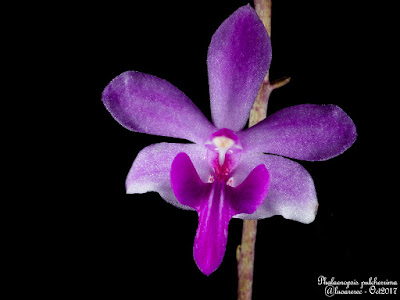Phalaenopsis pulcherrima is widely spread starting from north-east India through Burma, Thailand, Cambodia, Laos and Vietnam and further south through Malaysia, Sumatra to Borneo...
Phalaenopsis pulcherrima also called as The Beautiful Doritis, Doritis pulcherrima, Doritis pulcherrima f. alba, Doritis pulcherrima f. albiflora, Doritis pulcherrima f. apiculata, Doritis pulcherrima f. caerulea, Doritis pulcherrima f. nivea, Doritis pulcherrima f. purpurea, Doritis pulcherrima var. caerulea, Doritis pulcherrima var. apiculata, Doritis pulcherrima var. laotica, Phalaenopsis antennifera, Phalaenopsis buyssoniana, Phalaenopsis esmeralda, Phalaenopsis esmeralda var. albiflora, Phalaenopsis esmeralda var. candidula, Phalaenopsis esmeralda var. punctulata,; Phalaenopsis esmeralda var rubra, Phalaenopsis mastersii, Phalaenopsis pulcherrima, Phalaenopsis pulcherrima f. alba, Phalaenopsis pulcherrima f. albiflora, Phalaenopsis pulcherrima f. caerulea, is a species of the genus Phalaenopsis. This species was described by Johannes Jacobus Smith in 1933.
IDENTIFY PHALAENOPSIS PULCHERRIMA
Phalaenopsis pulcherrima is widely spread starting from north-east India through Burma, Thailand, Cambodia, Laos and Vietnam and further south through Malaysia, Sumatra to Borneo. In Thailand, they are found in all regions except the closest neighborhoods of Bangkok. Usually they are found at low altitudes, but there are known cases of encountering them at an altitude of up to 1300 m. They grow usually as orchids on the ground, in the shade of shrubs and bushes. Usually it is a sandy, well-permeable soil containing admixtures of organic debris.
It is a hot to warm growing lithophytic or terrestrial orchid, which reaching 15 cm in height, with a short, leafy stem, carrying oblanceolate to narrowly elliptic, obtuse to subacute, 5-15 cm long leaves.
The Beautiful Doritis blooms from summer until autumn on a simple, erect to 90 cm tall, inflorescence carrying many flowers of which to 10 may be open at once. The flowers are usually about 2.5 cm in diameter, but their size can range from 1.2 to 5.0 cm. They have extremely variable colors, and the colors can be from white to dark purple, and are generally pale pink-purple to purplish-pink. The 3-flap lip is usually darker than the flakes of both whorls, and its side plots are usually darker than the middle plots. The middle plot often has pale lavender lines in the middle, and yellow or creamy white around the disc.
PHALAENOPSIS PULCHERRIMA CARE AND CULTURE
Cultural information should only be used as a guide, and should be to be adapted to suit you. Your physical location; where you grow your plants, how much time you have to devote to their care, and many other factors, will need to be taken into account. Only then can you decide on the cultural methods that best suit you and your plants.
Light:
Phalaenopsis pulcherrima needs a light level of 8000-15000 lux. Strong air movement should be ensured all the time.
Temperature:
It is a thermophilic plant. The average summer temperature during the day is 31 ° C, at night 23-24 ° C, with a daily difference of 8 ° C. In winter the average day temperature is 28-31 ° C, night 18-20 ° C, which gives a daily difference of 9-12 ° C.
Humidity:
The Beautiful Doritis needs the humidity of 75-80% throughout the year.
Substrate, growing media and repotting:
Because Phalaenopsis pulcherrima grow in nature in a sandy, well-draining soil, the substrates used should be similar. You can use a medium graded bark mixed with perlite or pumice if these materials are available. In Thailand, a substrate composed of evenly crumbled bricks and small pieces of charcoal is commonly used. As additives to the aforementioned ingredients, crushed stone, tree fern fibers and charcoal can be used separately or in any combination thereof. The addition of chopped sphagnum moss is preferred, especially when the plants are grown in places with low humidity. Wood charcoal is also often added to ensure the air permeability of the substrate and protection against acidification. Clay baskets or flower pots are the most commonly used. When using plastic pots, it is recommended to improve drainage by enlarging existing holes and making additional ones. This is easily done by firing additional holes with the soldering iron.
Repotting or dividing plants should be done when the growth of new roots begins. This will allow the plant to adapt to the new substrate in the shortest possible time.
Watering:
From the end of spring until almost the end of autumn, the precipitation is moderate to heavy, after which the number decreases rapidly and a 4-month dry season lasts throughout the winter until the beginning of spring. During intensive growth, the plants should be watered profusely, but the substrate should dry quickly and must not be allowed to spread or become damp.
Fertilizer:
During the period of strong growth, the plants should be fertilized every week with 1/4-1/2 of the recommended dose of fertilizer for orchids. You can use of fertilizers with reduced nitrogen content in the late summer and autumn period, and increased phosphorus to improve flowering in the next season and strengthen new growth before winter.
These plants are not particularly sensitive to the salt content of the substrate, but care should be taken to avoid excessive accumulation of calcium and magnesium deposits. During intensive fertilization, the soil should be washed once a month before the next fertilization. First the plant is normally watered. After about an hour, after salt dissolves, the container is rinsed with clean water in an amount equal to its double volume.
Rest period:
Watering in winter should be reduced to a certain extent, especially in the case of Phalaenopsis pulcherrima cultivated in darker conditions of a short day typical of higher latitudes, but they should not dry up completely or be deprived of water for a long period of time. As the substrate will drain excess water well and be well aerated, it is possible to water them quite freely even during drought without damaging the health of the plant. Fertilization should be limited until spring, when stronger watering resumes.















COMMENTS